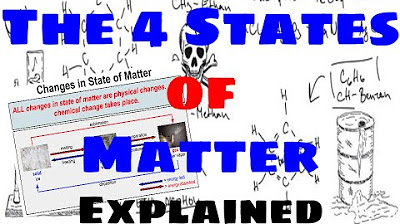(1 of 2) Measuring the Rotational Inertia of a Bike Wheel
Summary
TLDRIn this educational video, Mr. P and his students explore the concept of rotational inertia using a bicycle wheel. They apply the rotational form of Newton's second law to measure the wheel's moment of inertia, incorporating concepts like torque, angular acceleration, and the forces acting on the system. Through step-by-step analysis, they calculate the wheel's rotational inertia, using real measurements for the wheel's radius, hanging mass, and angular displacement. While the final result of 0.147 kg·m² raises some questions among the students, the session provides an engaging and detailed look at rotational motion principles.
Takeaways
- 😀 The goal of the experiment is to measure the rotational inertia (moment of inertia) of a bicycle wheel using a hanging mass and string.
- 😀 The bicycle wheel is assumed to have a frictionless axle to simplify the calculations.
- 😀 The forces acting on the bicycle wheel include gravity, normal force, and tension in the string, while the hanging mass experiences gravity and tension.
- 😀 The tension in the string is the primary force that applies torque to the bicycle wheel, causing it to rotate.
- 😀 Torque is calculated as the product of the radius, force, and the sine of the angle between the force and the radius vector.
- 😀 The rotational inertia of the wheel is found by equating the torque to the moment of inertia times the angular acceleration.
- 😀 The force of tension in the string can be determined by summing forces on the hanging mass and solving for tension using Newton's second law.
- 😀 The tension in the string and the forces on the wheel and mass must be carefully analyzed in terms of direction (positive and negative).
- 😀 The linear acceleration of the hanging mass is related to the angular acceleration of the wheel by the equation: tangential acceleration = radius × angular acceleration.
- 😀 The angular acceleration of the wheel is constant because the net torque and rotational inertia are constant, which allows the use of uniformly angularly accelerated motion equations (U fishy M).
- 😀 To solve for rotational inertia, key variables such as the radius, hanging mass, acceleration due to gravity, angular displacement, and time are measured. Using these, the rotational inertia of the wheel is calculated to be 0.147 kg·m².
Q & A
What is the main goal of the experiment discussed in the video?
-The main goal is to measure the rotational inertia (moment of inertia) of a bicycle wheel by using a hanging mass and analyzing the forces acting on the system.
How does the hanging mass contribute to the wheel's motion?
-The hanging mass applies a torque through the tension in the string, which causes the bicycle wheel to angularly accelerate.
Why is the axle of the bicycle wheel assumed to be frictionless in the experiment?
-Assuming the axle is frictionless simplifies the analysis by eliminating frictional forces that could interfere with the measurement of the wheel's rotational inertia.
What forces are identified in Bobby's free body diagram of the system?
-Bobby identifies the force of gravity acting on both the wheel and the hanging mass, the normal force acting on the wheel, and the tension forces acting at both ends of the string.
What is the role of torque in this experiment?
-Torque causes the bicycle wheel to rotate. The tension in the string applies a torque to the wheel, which leads to its angular acceleration.
What does Newton's second law in rotational form state about the system?
-Newton's second law in rotational form states that the net torque acting on an object equals its rotational inertia times its angular acceleration.
How is the tension in the string calculated using the forces on the hanging mass?
-The tension is calculated by summing the forces acting on the hanging mass. The net force equals the tension minus the gravitational force, which leads to the equation for tension as the hanging mass times the difference between gravitational acceleration and the acceleration of the mass.
How do linear acceleration and angular acceleration relate in this experiment?
-The linear acceleration of the hanging mass is related to the angular acceleration of the wheel by the equation: tangential acceleration = radius × angular acceleration.
Why is the angular acceleration of the wheel constant in this experiment?
-The angular acceleration is constant because the net torque, the rotational inertia, and other factors like tension remain constant throughout the experiment, resulting in uniform angular acceleration.
What is the final value for the rotational inertia of the bicycle wheel?
-The final value for the rotational inertia of the bicycle wheel is approximately 0.147 kg·m².
Why do Billy and Bobby find it difficult to understand the result of the rotational inertia?
-Billy and Bobby find it difficult to understand the result because they have no frame of reference to judge whether the value of 0.147 kg·m² makes sense for the rotational inertia of a bicycle wheel.
What does Mr. P suggest as a way to help Billy and Bobby understand the result better?
-Mr. P suggests that comparing the measured rotational inertia with typical values of rotational inertia for similar objects could help Billy and Bobby understand whether the result is reasonable.
Outlines

This section is available to paid users only. Please upgrade to access this part.
Upgrade NowMindmap

This section is available to paid users only. Please upgrade to access this part.
Upgrade NowKeywords

This section is available to paid users only. Please upgrade to access this part.
Upgrade NowHighlights

This section is available to paid users only. Please upgrade to access this part.
Upgrade NowTranscripts

This section is available to paid users only. Please upgrade to access this part.
Upgrade NowBrowse More Related Video

The Four States of Matter - Explained

Lab Equipment - Explained

3. Gr 11 Life Sciences - Population Ecology - Theory 3 Mark Recapture Method

4. Gr 11 Life Sciences - Population Ecology - Worksheet 1

PENJASKES KELAS X - SOFTBALL

Introduction to Culture [AP Human Geography Review Unit 3 Topic 1]

Menentukan Mr ( massa molekul relatif )
5.0 / 5 (0 votes)